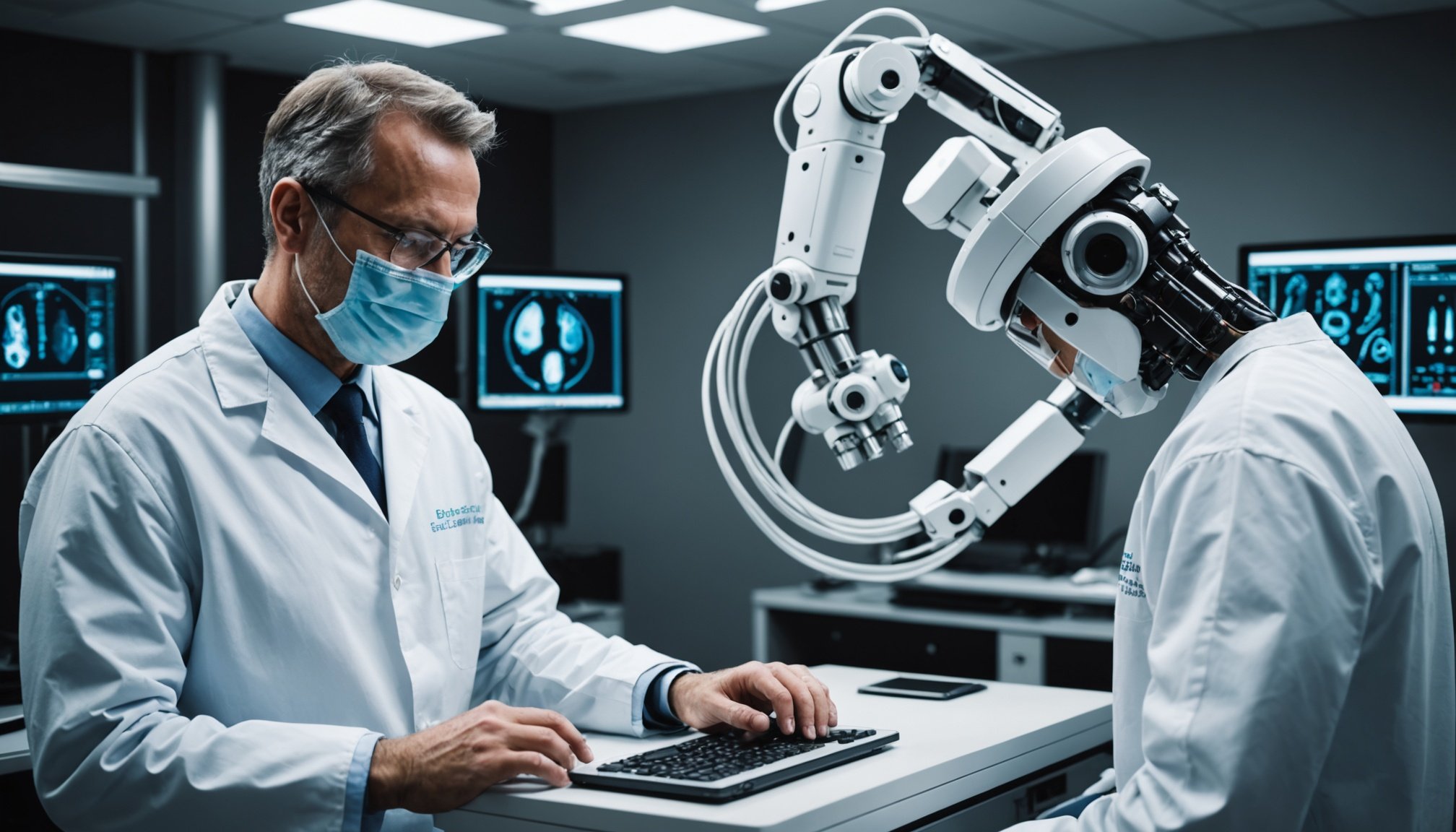Essential Factors UK Surgeons Must Weigh in Robotic-Assisted Surgery: A Comprehensive Guide
What is Robotic-Assisted Surgery?
Robotic-assisted surgery, often associated with minimally invasive surgery, has revolutionized the way surgeons perform various surgical procedures. This advanced technique utilizes sophisticated robotic systems, such as the da Vinci System and the Mako system by Stryker, to enhance precision, flexibility, and control during operations.
How Does Robotic-Assisted Surgery Work?
In robotic-assisted surgery, the surgeon uses a computer console to control mechanical arms equipped with surgical instruments. A camera arm provides a high-definition 3D view of the surgical site, allowing the surgeon to make precise movements. Here’s a step-by-step breakdown:
Have you seen this : Exploring Cutting-Edge Robotic Surgery Innovations for Gynecological Procedures in the UK
- Preparation: The surgeon makes small incisions to insert the instruments and a thin tube with a camera.
- Surgical Procedure: The surgeon controls the robotic arms from the console, guided by the 3D images. The robot mimics the surgeon’s hand movements, enabling precise and delicate operations.
Key Applications of Robotic-Assisted Surgery
Robotic-assisted surgery is versatile and is used in various surgical disciplines, including:
- Cardiac Surgery
- Colorectal Surgery
- General Surgery
- Gynaecological Surgery
- Head and Neck Surgery
- Thoracic Surgery
- Urological Surgery
For example, in orthopaedic surgery, the Mako robotic arm assists in joint replacement surgeries by creating a detailed 3D model of the patient’s joint based on CT scan results. This pre-operative planning ensures accurate implant placement and minimizes soft tissue damage.
This might interest you : How can UK health professionals create a welcoming environment for LGBTQ+ patients?
Advantages of Robotic-Assisted Surgery
The benefits of robotic-assisted surgery are numerous and significant:
Enhanced Control and Visibility
- Surgeons have improved control over the surgical instruments, allowing for more precise movements.
- High-definition 3D imaging provides a clear and enlarged view of the surgical site, reducing the risk of errors.
Minimally Invasive
- Procedures are performed through tiny incisions, which reduces the risk of infections and blood loss.
- Less pain and discomfort post-surgery, leading to a quicker recovery time.
Reduced Complications
- Fewer complications such as infections and transfusions.
- Less noticeable scars due to the smaller incisions.
- Shorter hospitalization and faster return to normal activities.
Risks and Considerations
While robotic-assisted surgery offers many advantages, it is not without risks and considerations:
Potential Risks
- Infections: Similar to conventional surgery, there is a risk of infection.
- Bleeding: Although reduced, there is still a risk of bleeding.
- Mechanical Failure: Though rare, mechanical failure of the robotic system can occur.
Patient Selection
- Ideal candidates are those who have not had multiple abdominal surgeries.
- Patients with prevalent cardiovascular and pulmonary diseases require careful consideration before undergoing robotic-assisted surgery.
Cost and Environmental Impact
Cost Considerations
Robotic-assisted surgery often comes with a higher initial cost due to the sophisticated technology involved. However, the long-term benefits, such as reduced recovery time and fewer complications, can offset these costs.
| Aspect | Robotic-Assisted Surgery | Conventional Surgery |
|---|---|---|
| Initial Cost | Higher due to technology | Lower equipment costs |
| Recovery Time | Shorter hospital stay and recovery | Longer hospital stay and recovery |
| Complications | Fewer complications and infections | Higher risk of complications and infections |
| Scarring | Less noticeable scars | Larger scars |
Environmental Impact
The environmental impact of robotic-assisted surgery is generally lower due to the minimally invasive nature of the procedures. This results in less waste from surgical materials and potentially fewer resources needed for post-operative care.
Patient Experience and Recovery
Personalized Care
Robotic-assisted surgery, especially with systems like Mako, offers personalized care through detailed pre-operative planning. For instance, a 65-year-old patient who underwent Mako robotic arm-assisted hip replacement surgery reported significant improvement in mobility and comfort just four weeks post-surgery.
Recovery Time
The recovery time for robotic-assisted surgery is typically shorter compared to traditional open surgery. Patients can return to their everyday activities in as little as two to three weeks, although individual recovery times may vary.
Future Developments and Research
Integration of Artificial Intelligence
Future developments in robotic-assisted surgery are likely to include the integration of artificial intelligence (AI) to enhance precision and decision-making during operations. AI can help in analyzing real-time data and providing predictive insights to surgeons.
Ongoing Research
Research continues to focus on improving the technology and addressing adoption barriers. A study on the challenges of robotic-assisted surgery adoption highlights the need for better training programs, cost-effectiveness analysis, and addressing the learning curve for surgeons.
Practical Insights and Actionable Advice for Surgeons
Training and Experience
- Surgeons should undergo comprehensive training programs to master the use of robotic systems.
- Continuous practice and experience are crucial in improving skills and reducing the learning curve.
Patient Communication
- Clear communication with patients about the benefits and risks of robotic-assisted surgery is essential.
- Providing detailed information on what to expect during and after the surgery can help manage patient expectations and anxiety.
Team Collaboration
- Robotic-assisted surgery often requires a team effort. Ensuring that all team members are well-trained and coordinated can enhance the success of the procedure.
Robotic-assisted surgery represents a significant advancement in surgical techniques, offering enhanced precision, reduced recovery time, and fewer complications. As the technology continues to evolve, it is crucial for surgeons to weigh the essential factors, including patient selection, cost considerations, and the integration of new technologies like AI.
By understanding these factors and staying updated with the latest developments, surgeons can provide the best possible care for their patients, leading to improved outcomes and higher patient satisfaction.
Additional Resources
For those interested in delving deeper into the subject, here are some additional resources:
- Top Doctors: Robotic Surgery – A detailed guide on robotic-assisted surgery, including its applications and benefits.
- Carrothers Orthopaedics: Mako Robotic Arm Assisted Surgery – Insights into the use of Mako technology in orthopaedic surgeries.
- ResearchGate: An Introduction to Robotically Assisted Surgical Systems – A comprehensive overview of the historical and current developments in robotic-assisted surgery.
These resources provide a wealth of information and can serve as a starting point for further research and understanding of this innovative surgical approach.











